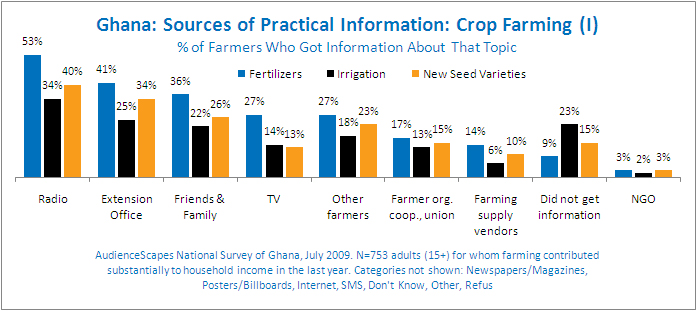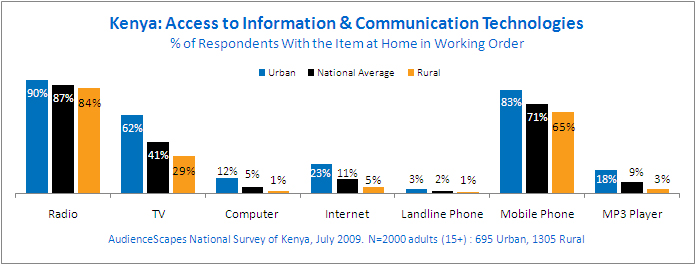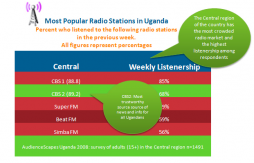Finding data on media consumption can be difficult, but the real trouble comes in interpreting it – what does it mean if people in one country get most of their news from radio, while in another from television? How are mobile phones changing the media and communications landscape? How can this data be used to help keep the greatest number of people informed? And why does this information matter?
AudienceScapes, a project of InterMedia, tracks media and ICT consumption in developing countries around the world. Currently the site has detailed information about Ghana, Uganda, Kenya, Sierra Leone, Columbia, Nicaragua, Guatemala and Peru. The site is a useful resource for detailed breakdowns on how different communities are using and consuming media.
In it's own words, AudienceScapes provides “detailed overviews of national media and communication landscapes from the user perspective, with details on media use, technology use and word-of-mouth patterns,” with the ultimate goal of ““facilitat[ing] healthier two-way communication in the development process by making the practitioners more aware of the information assets and needs of citizens and policymakers in developing countries. “
The site breaks down viewing habits and consumption, with information gathered from national surverys, interviews with officials in country, and interviews with local media consumers. The data can help those working in the development field know how to best reach targeted audiences. Likewise, NGOs can use the data to develop campaigns that reach the maximum number of people.
AudienceScapes has the most data on Kenya and Ghana. There are detailed case studies on the use of media by women, and reharding issue areas such as health, agriculture and livestock, and mobile banking. The case studies are helpful to understand how survey-respondents receive information and news. For example, a case study in Ghana about how farmers stay informed on agricultural developments, showed that most survey respondents got their agricultural news (such as weather and crop planning updates) from the radio.

NGOs ranked low as information sources for agricultural information in this survey, so future projects deploying in the area can use this information to either adapt their strategies to fit into the current news sources, or plan to carve out a niche in an area that hasn’t traditionally been used.
Other surveys track communications' penetration levels; in the Kenyan country overview, the chart shows that radio and mobile phones are vastly more common than any other means of communication.

Again, data like this can be used to not only draw conclusions about how best to reach targeted audiences, but can also be used to examine where the current systems are lacking and either build up or abandon projects that aren't working.
The surveys are expanding, with information on Libera, Guina, Chad, Pakistan and Nepal coming soon. For now, we’re pleased that someone is taking a deeper look at how news is consumed around the world, and how to best reach audiences.
Anne-Ryan Heatwole is a writer for MobileActive.org
| AudienceScapes Investigates How the World Stays Informed data sheet 5030 Views | |
|---|---|
| Countries: | Colombia Ghana Guatemala Kenya Nicaragua Peru Sierra Leone Uganda |


Post new comment